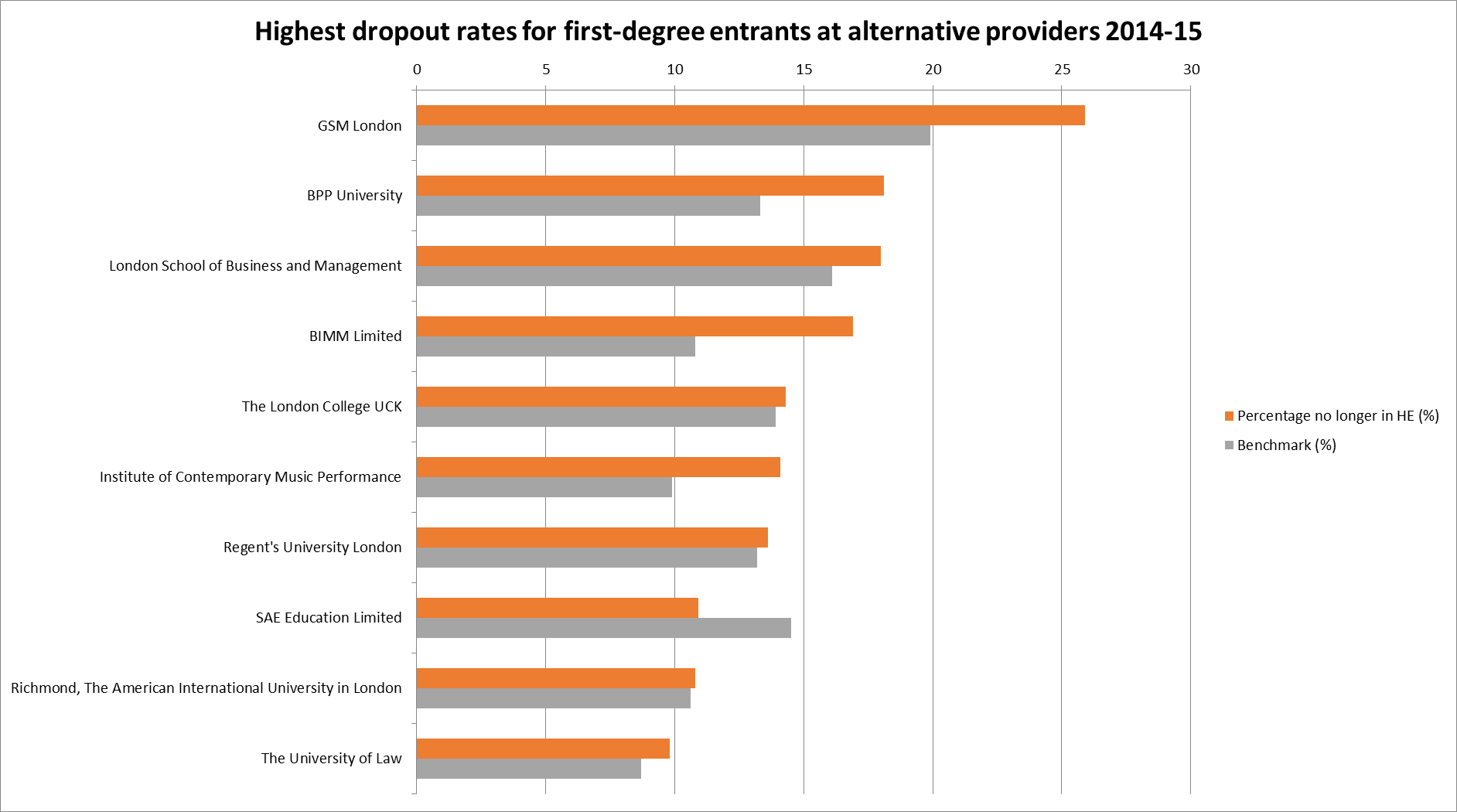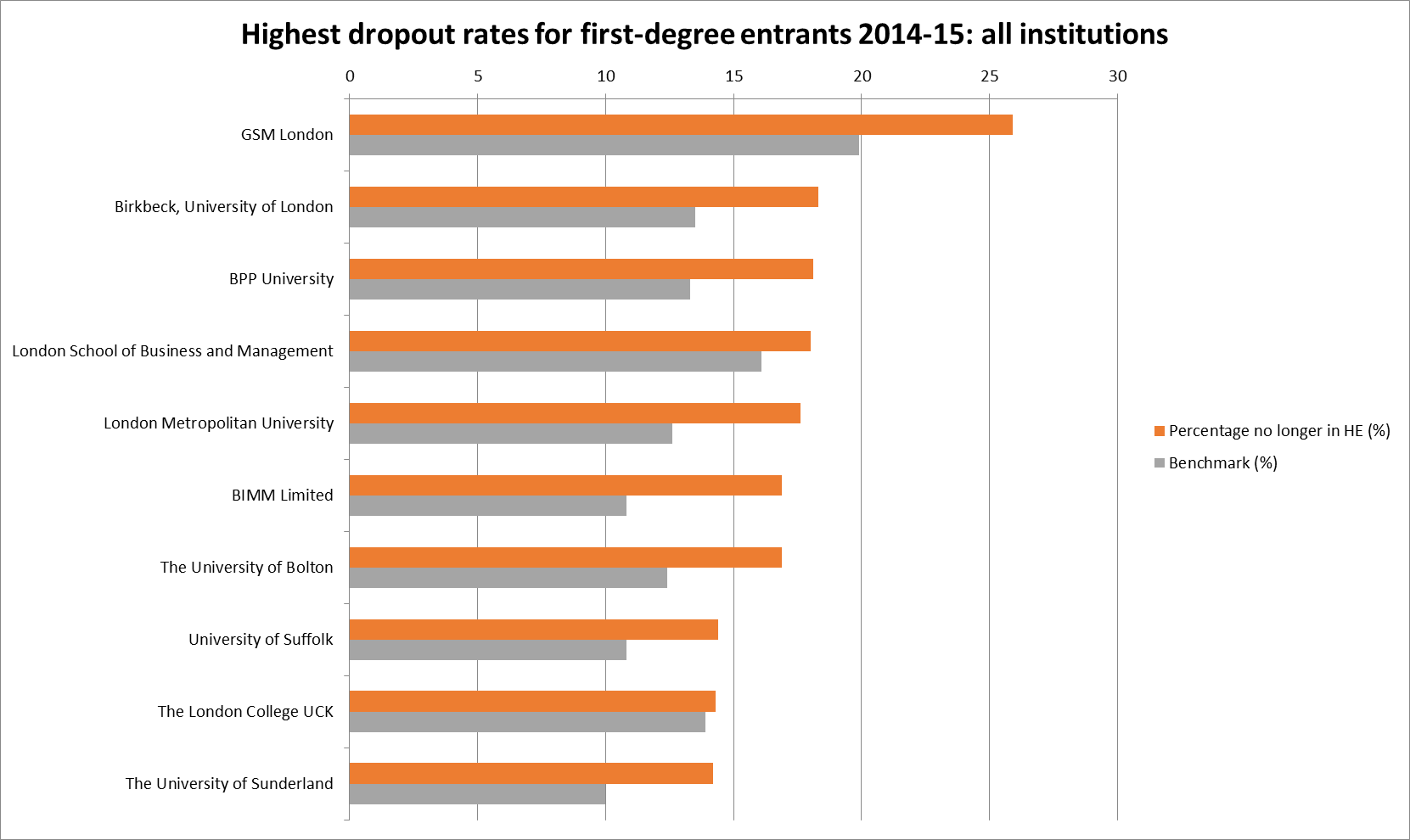A common charge levelled against some new providers of higher education is that their students are more likely to drop out than those at traditional universities. This claim is often countered by fledgling institutions pointing out that their student cohorts hail from more disadvantaged backgrounds.
In England, these points can now be put to the test to some extent with the first, albeit experimental, release of statistics looking at the dropout rates and student backgrounds of so-called alternative providers alongside more established universities.
According to the data released by the Higher Education Statistics Agency, private higher education providers do make up half of the 10 institutions with the highest dropout rates in England for those pursuing a first degree (if considering only institutions with 100 or more students).
The statistics, which look at the proportion of students who left higher education in the year after starting their course, show that GSM London, a private college based in southeast London, had by far the highest dropout rate, 26 per cent. GSM’s figure was almost 8 percentage points higher than the private provider with the next highest dropout rate, BPP University, with 18.1 per cent.

It is not the first time that GSM has come under the spotlight among private providers. A report in 2014 by the National Audit Office, which scrutinises public spending, named GSM among five institutions that had accounted for half the growth in public loan-backed student numbers at private colleges between 2011-12 and 2013-14.
It is true to say that in the Hesa statistics, the alternative providers – which all have courses where students can access public loans – are not alone in terms of high dropout rates. Although GSM leads the pack, there is a batch of both alternative and mainstream providers with dropout rates in the high teens (see chart below).

As well as the raw dropout rate, Hesa publishes a “benchmark” figure, which takes the average dropout rate for the whole country (7.7 per cent for England) and adjusts it to reflect each institution’s specific characteristics, such as its location or the background of its students.
Several of the 10 private colleges and universities with the highest dropout rates are actually fairly close to their benchmarks (see first graph above), and SAE Education – the firm that runs the SAE Institute, a private, creative media college with sites across the UK – is actually below its benchmark.
This would suggest that the students who tend to be recruited by some of those providers could be more likely to be from disadvantaged areas where fewer people traditionally go into higher education – the caveat some private providers use when explaining higher dropout rates.
However, specific Hesa figures on this topic do not always back up the claim: the percentage of young first-degree entrants (under 21) from what are known as “low participation neighbourhoods” was only 2.7 per cent at GSM in 2015-16 against a benchmark of 9.6 per cent. Others with high dropout rates are also below their benchmark (BPP University had 7.6 per cent, benchmark 13.2 per cent; the London School of Business and Management had 5.4 per cent, benchmark 9.2 per cent).
GSM’s provost, Debi Hayes, claimed that the institution’s student body was “unlike just about any other institution, with a greater number of mature students who often have complex home and background situations that are hard to capture in benchmarking categories”.
“Many of these students struggle with the demands of study and make the difficult decision not to continue,” she said. “Taking a more exclusionary approach at the outset might push us higher up the retention tables, but we are not prepared to deny opportunities in this way.”
The Hesa figures do show that GSM has a larger proportion of mature students, and the dropout rate for them is much closer to the institution's benchmark (20.3 per cent for first-degree students, benchmark 19.2 per cent). However, the proportion of mature students from low-participation areas (and with no previous background of higher education) was still low, at 4.3 per cent.
What this perhaps illustrates is that, above all, at this granular level, widening participation statistics do have to be treated with caution. But looking solely at dropout rates, some new providers certainly have a case to answer, just as much as the universities with poor retention do.
Find out more about THE DataPoints
THE DataPoints is designed with the forward-looking and growth-minded institution in view
Register to continue
Why register?
- Registration is free and only takes a moment
- Once registered, you can read 3 articles a month
- Sign up for our newsletter
Subscribe
Or subscribe for unlimited access to:
- Unlimited access to news, views, insights & reviews
- Digital editions
- Digital access to THE’s university and college rankings analysis
Already registered or a current subscriber?




